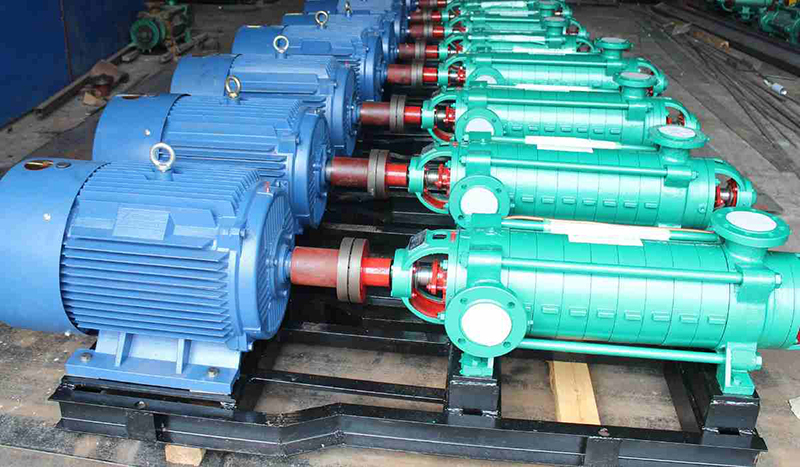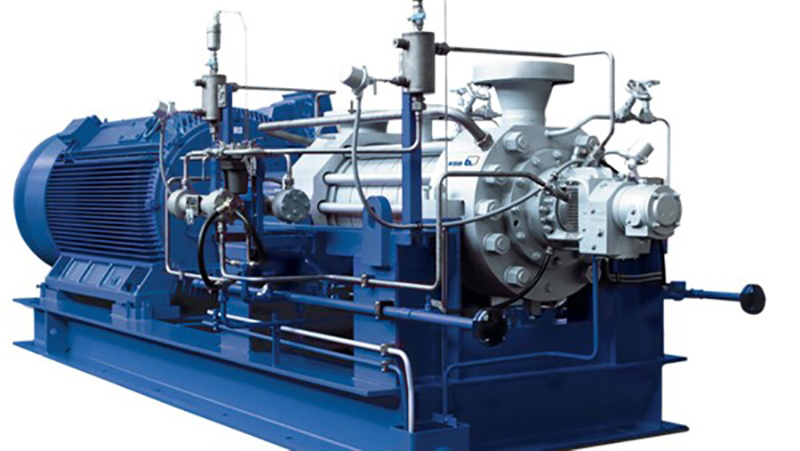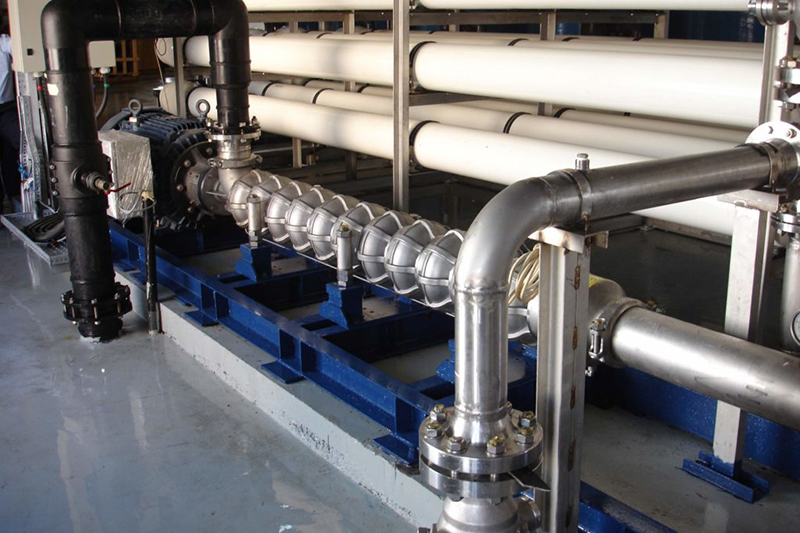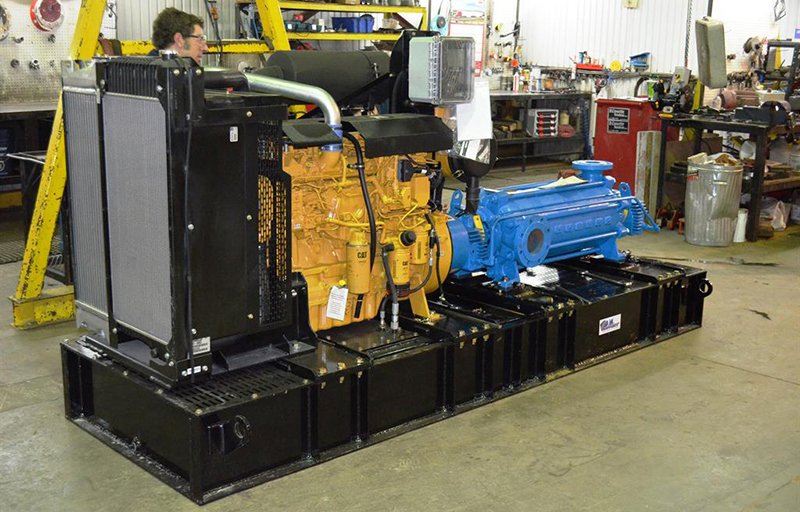A specialized type of pump, the multistage high-pressure pump, is designed to generate the high pressures needed in several industries, including oil and gas, chemical processing, water treatment, and power generation. These pumps excel in applications where other pump types fail to generate the required pressure.
Each multistage high-pressure pump comprises multiple stages, each consisting of an impeller or rotor with blades that spin inside a stator fitted with matching blades. Each step accelerates the fluid as the rotor rotates, increasing its velocity and pressure. The pressure generated by each stage combines with the previous step, resulting in a high-pressure output.
These high-pressure pumps are often utilized when moving fluids over long distances or overcoming resistance in a system. They are also used when it is essential to control the flow rate and pressure of the fluid precisely. These pumps have various applications, including hydraulic fracturing, water injection for oil recovery, and high-pressure water jet cutting.
How To Maintain Multistage High-Pressure Pumps?
Maintenance of multistage high-pressure pumps is essential for ensuring their longevity and optimal performance. Consider these maintenance tips for ensuring the proper upkeep of multistage pressure pumps:
- Inspect the pump and associated components, such as the motor, bearings, and seals. Look for any indications of wear and tear, leakages, or any other type of damage.
- Check the alignment of the pump and motor to ensure they are correctly aligned. Misalignment can cause excessive wear and damage to the pump and motor components.
- Monitor the pump’s performance and operating conditions, such as pressure, flow rate, and temperature. Record this data regularly to detect any changes or abnormalities indicating a problem.
- Follow the manufacturer’s recommended maintenance schedule for changing the oil and replacing worn parts, such as the impeller, shaft, and bearings.
- Ensure the pump is clean and free of debris or buildup that could clog the system or damage the components.
- Check the suction and discharge valves for proper operation and ensure they are not clogged or damaged.
- Use only recommended lubricants and fluids for the pump, and make sure they are changed according to the manufacturer’s approvals.
- Ensure the pump is operated within its rated specifications and avoid operating it at extreme temperatures or pressures.
- Train staff on the proper operation and maintenance of the pump, including safety procedures.
- Have the pump regularly inspected and serviced by an expert technician or service provider to ensure it is in good working condition.

Advantages Of Installing Multistage High-Pressure Pumps
Multistage high-pressure pumps have several advantages over other types of pumps, including:
-
High Pressure
High-pressure pumping is essential in many industries and applications, including oil and gas exploration, water treatment, food processing, pharmaceutical manufacturing, etc. High-pressure pumps are designed to deliver fluids at higher pressures than conventional pumps, allowing for more efficient and effective pumping of fluids.
One of the primary advantages of high-pressure pumps is that they can transport fluids over long distances and through pipelines with minimal pressure loss. This is particularly important for industries that require the transportation of liquids over significant distances, such as the oil and gas industry. However, high-pressure pumps can also boost the pressure of fluids weakened by the resistance of long pipelines or other equipment.
High-pressure pumps are generally designed with specialized components, such as impellers, casings, and seals, that can withstand the high pressures generated by the pump. These components are carefully engineered to ensure the pump can deliver fluids at high pressures with minimal wear and tear. Additionally, high-pressure pumps are often designed with multiple stages that can increase the pressure of the liquid even further, allowing for even more efficient and effective pumping.
Multistage high-pressure pumps offer a range of benefits for industries that require the efficient and reliable transportation of fluids at high pressures. These pumps are designed to be durable, efficient, and versatile, making them essential in many applications.

-
Energy Efficiency
Energy efficiency is vital for any pumping application, as energy costs can account for a significant portion of operating expenses. Multistage high-pressure pumps are designed to operate more efficiently than other pumps, resulting in lower energy consumption and reduced operating costs.
One key factor contributing to the energy efficiency of multistage high-pressure pumps is their design. These pumps are typically designed with multiple stages, which allows them to deliver fluids at higher pressures with lower flow rates. By operating at higher pressures, the pump can transport fluids over longer distances and through smaller pipelines, reducing the need for additional pumping equipment.
Additionally, multistage high-pressure pumps may be equipped with variable frequency drives (VFDs) or control systems operating at optimal speeds and flows. By adjusting the pump speed to match the required flow rate, these control systems can reduce energy consumption and improve overall efficiency.
The energy efficiency of multistage high-pressure pumps can be cost-effective. These pumps are designed to minimize energy losses and maximize the efficiency of the pumping process, resulting in reduced energy consumption and operating costs.

-
Space Saving
Multistage high-pressure pumps are an excellent choice for applications with limited space, such as offshore oil and gas platforms, chemical plants, or other industrial facilities. These pumps are designed to deliver high pressure in a compact package, saving valuable space and reducing the footprint of the pumping equipment.
The compact size of multistage high-pressure pumps is achieved by their use of multiple stages, which allows the pump to deliver high pressure with a relatively small diameter impeller. These contrast single-stage pumps require a larger diameter impeller to achieve the same pressure output. As a result, multistage pumps can deliver high-pressure fluids while taking up less space in the installation site.
Multistage high-pressure pump save space through their vertical or horizontal configurations. Vertical multistage pumps are designed to be installed in a compact, space-saving manner, with the pump motor located above the pump. This allows for a smaller footprint and easier access to maintenance and repairs. Horizontal multistage pumps are also available, and these pumps are designed to be installed in a space-saving manner with the pump motor located to the side of the pump.
The multistage high-pressure pump also offers versatility in terms of its installation options. These pumps can be installed either horizontally or vertically, allowing greater flexibility in the available installation space. In addition, depending on the application’s requirements, multistage high-pressure pumps can be installed in series or parallel configurations.

-
Durability
Durability is one feature to consider when selecting a pumping system, especially when the pumping equipment is exposed to harsh conditions, abrasive or corrosive fluids, or high pressures. Multistage high-pressure industrial pumps are designed with durability, and their construction and materials are carefully chosen to ensure long-term reliability and performance.
One way that multistage high-pressure pumps achieve durability is by using high-quality materials in their construction. These pumps are often made from high-grade stainless steel, which is corrosion-resistant and provides excellent strength and durability. Additionally, multistage high-pressure pumps may use specialized coatings or platings to enhance their resistance to corrosion and wear further.
The construction of multistage high-pressure pumps also contributes to their durability. These pumps are designed with a robust casing and impeller, which can withstand the stresses of high-pressure pumping without deforming or breaking. Additionally, multistage pumps may use advanced sealing mechanisms, such as mechanical seals or gland packing, to prevent leaks and ensure long-term reliability.
Multistage high-pressure pumps deliver reliable performance in harsh and demanding environments. Their construction, materials, and ease of maintenance are all carefully engineered to ensure long-term durability and reliability, making them an ideal choice for a wide range of industrial pumping applications.

Conclusion
Multistage high-pressure pumps have proven to be a reliable and efficient solution for various applications that require high-pressure liquid transfer. These pumps operate by utilizing a series of impellers to increase the pressure of the fluid as it passes through each stage. The design of these pumps allows for a more significant pressure increase compared to single-stage pumps.
Multistage high-pressure pumps are used in several industries. They are also commonly used in household applications such as pressure washers and car washes. Multistage high-pressure pumps remain essential in various applications with their high performance and versatility.


